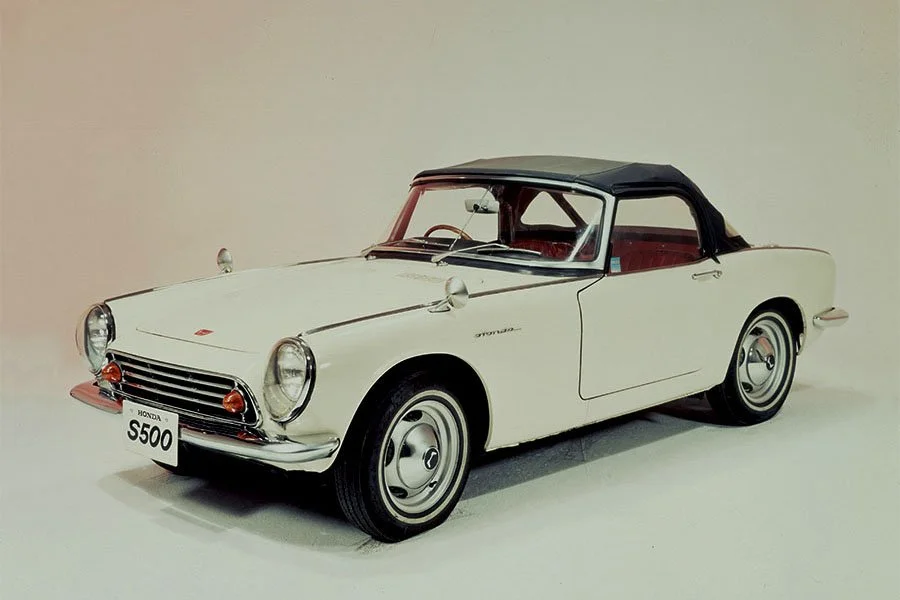Guide: NSX Daddy - a Historical & Technical Appraisal of the Honda HP-X (1984)
/BACKGROUND
After the first generation Civic had proven Honda’s breakthrough model as an auto maker, the firm spent the next ten-or-so years focused on refining its core principles of well-built and reliable vehicles that were competitively priced and economic to run.
However, as trading conditions steadily began to improve following the ravaging effects of a mid seventies Oil Crisis, Honda looked to embark on a brand building exercise with a staggered return to motor racing having abandoned the sport at the end of 1968.
In 1979, Honda revived its Grand Prix motorcycle programme and, in 1980, the company found itself back in four-wheeled racing when it began to supply a V6 Formula 2 engine which went on to win the F2 championship in 1981, 1983 and 1984. Buoyed by this success, the Japanese company decided to re-enter Formula 1 as an engine provider having last competed at the top tier of auto racing in the mid-late 1960s when it won the 1965 Mexican and 1967 Italian Grand Prixs.
In the midst of its impressive Formula 2 return, Honda also began to explore the possibility of creating a flagship production sports car that would add a little stardust to the rest of the range.
The first step came in 1982 when Honda commissioned renowned Italian styling house Pininfarina to create a state-of-art design study based around the all-conquering F2 engine. Dubbed HP-X (Honda Pininfarina eXperimental) it would become the Japanese firm’s first true concept and represented a radical departure from anything that had previously worn the Honda badge.
The HP-X was absolutely loaded with advanced aerodynamic features along with innovative cockpit technology and, following an intensive development programme, was unveiled on Pininfarina’s stand at the Turin Motor Show in November 1984.
CHASSIS
In addition to its cutting edge appearance, the HP-X abandoned Honda’s preferred front-engined, front-drive layout in favour of a mid-engined, rear drive set-up with four-wheel steering.
The new car was based around a custom monocoque bodyshell with independent MacPherson strut / multi-link suspension and disc brakes all round.
Five-bolt alloy wheels were in tune with the rest of the HP-X by way of a highly efficient five-blade design that maximised brake cooling and aerodynamic efficiency.
ENGINE / TRANSMISSION
In the engine bay was a transversely mounted iteration of Honda’s normally aspirated two-litre 80° V6 as used in Formula 2 racing.
These Nobuhiko Kawamoto-designed engines were continually refined between 1980 and ‘86 (Types RA260E to RA266E). They were based around a cast-iron block with an aluminium alloy twin cam 24 valve head and displaced 1996cc thanks to a bore of 90mm and exceedingly short 52.3mm stroke. Fuel-injection was employed along with dry-sump lubrication. Compression ratios were never published.
For the HP-X, peak output was said to have been de-tuned to 225bhp from well beyond 300bhp at over 10,000rpm in racing trim.
Transmission was through a five-speed gearbox.
BODYWORK
Pininfarina’s HP-X design was most obviously characterised by its striking Perspex roof canopy and dramatically angled door-less flanks.
The single-piece forward section of the roof was hinge-mounted to a discrete roll over bar located behind the seats. Further back, Pininfarina added a secondary roof section that doubled as a driver-controlled air brake.
Delicately slatted side elements mimicked Pininfarina’s recently unveiled Ferrari Testarossa but uniquely wrapped around onto the rear deck where they were opened up for engine cooling.
Up front, the nose line was angled to match the cockpit profile to create a treatment that, when combined with the sci-fi-esque cockpit, was highly reminiscent of those startling design concepts which emerged during the wedge heyday of the late 1960s and early 1970s.
Fixed headlights were adopted instead of pop-up units and Pininfarina ensured the HP-X had a svelte profile thanks to satin black aprons and skirts. This effect was further accentuated by way of a two-tone white over blue colour scheme complete with red coachline.
At the back, a cut-off Kamm tail housed a full width bank of concealed lights, but the HP-X’s most striking rearward feature was undoubtedly its enormous underbody venturi designed to maximise ground effect.
Materials-wise, Pininfarina made extensive use of composite materials such as honeycomb, carbonfibre and Kevlar.
INTERIOR
Inside, Pininfarina went to town with a futuristic cockpit that employed an array of highly advanced features, some of which wouldn’t make it into the mainstream for another couple of decades.
The flat full width dash was trimmed in textured grey fabric and sloped down towards the occupants in a fashion similar to those used by Prototype racing cars of a generation prior. Housed directly behind the two-spoke steering wheel was a digital head-up display that projected data onto the windscreen.
Joining the dash and transmission tunnel was a central console complete with Honda’s digital Electronic Drive Support System that featured real-time telemetry, satellite-navigation, live sonar-generated traffic updates and a CD playing audio system.
Single-piece bucket seats were adjustable fore / aft only and trimmed in a mixture of red and light grey alcantara suede fabric to match the rest of the interior. Behind the seats was a luggage platform complete with a pair of fitted suitcases.
WEIGHT / PERFORMANCE
No weight figures were ever published but a figure somewhere in the region of 1000-1100kg would seem likely.
Top speed was expected to have been in the region of 140mph with a 0-62mph time of circa 5.5 seconds.
SUBSEQUENT HISTORY & LEGACY
Having never been conceived with production in mind, it was no surprise that the HP-X remained a one-off. However, within a few months of its completion, Honda gave the green light for a V6-powered mid-engined production car that ultimately came to be known as the NSX...
Text copyright: Supercar Nostalgia
Photo copyright: Honda - https://global.honda/ & Pininfarina - https://pininfarina.it/






































